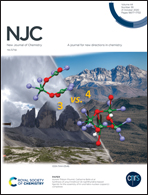Polyethylene glycol-bonded triethylammonium l-prolinate: a new biodegradable amino-acid-based ionic liquid for the one-pot synthesis of bis(pyrazolyl)methanes as DNA binding agents†
Abstract
Polyethylene glycol-bonded triethylammonium L-prolinate ([PEG-TEA]LP) was prepared as a new, highly efficient, reusable and biodegradable amino-acid-based ionic liquid catalyst using cheap and easily accessible starting materials. The [PEG-TEA]LP chemical structure was characterized via FT-IR and 1H-NMR. [PEG-TEA]LP biodegradability was also assessed based on the ability of Escherichia coli bacteria to make use of this ionic liquid as a nutrient. In continuation, [PEG-TEA]LP was successfully applied as a catalyst for the one-pot pseudo-five-component synthesis of bis(pyrazolyl)methanes. High synthesized product diversity was obtained with good to excellent yields and short reaction times. Also, some bis-products of bis(pyrazolyl)methanes as more complex products were prepared to show the generality and practical efficiency of the presented strategy. The cytotoxicity of the synthesized bis(pyrazolyl)methanes against the K562 cancerous cell line was also checked and, in some cases, they were more cytotoxic than cisplatin. The DNA binding ability of the synthesized compounds was also studied via a UV-visible spectroscopic method, and the obtained results proved their interaction with DNA minor grooves.



 Please wait while we load your content...
Please wait while we load your content...